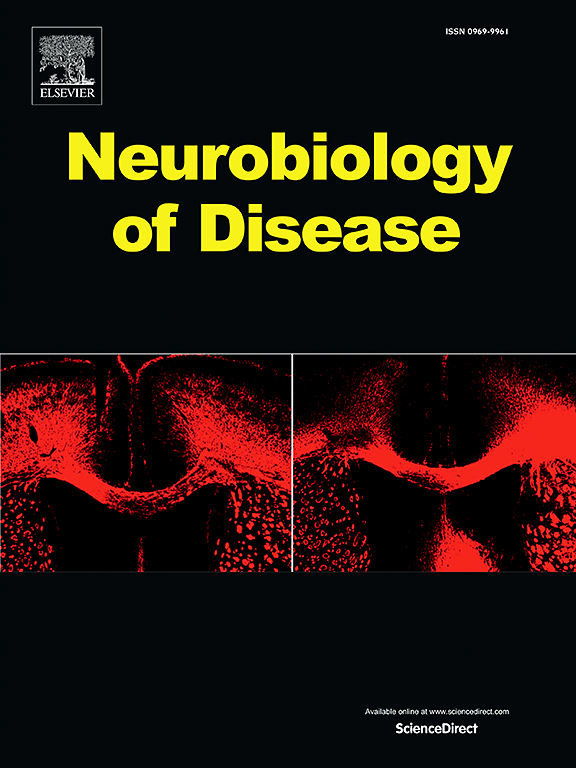Glucosylsphingosine is a potential fluid-based biomarker of lysosomal dysfunction in Cln3Δex7/8 mice
IF 5.1
2区 医学
Q1 NEUROSCIENCES
引用次数: 0
Abstract
CLN3 disease is a rare fatal juvenile neurodegenerative lysosomal storage disease. Challenges in tracking underlying disease biology have hindered the identification of effective therapeutic targets and the ability to execute clinical trials in this rare disease. While diagnostic biomarkers are readily available, biomarkers that reflect the underlying core lysosome dysfunction are lacking. In the present study, CLN3Δex7/8 iPSC derived models were used to link hallmark cellular pathology and lysosomal parameters at the cellular level to potential novel biomarkers. A Cln3Δex7/8 disease mouse model was used to link established clinical diagnostic biomarkers and hallmark cellular pathology to novel biomarkers in tissue and biofluid in-vivo. Non-invasive retinal imaging modalities were used to identify the established visual dysfunction in the Cln3Δex7/8 disease mouse model. These techniques better characterize significant and progressive retinal layer degeneration, bipolar cell dysfunction, and autofluorescent aggregate deposition in Cln3Δex7/8 mice. Retinal imaging biomarkers also coincided with an increase in ATP synthase subunit C, a hallmark disease pathology, in the retina and brain. Additionally, quantitative lipidomic analyses of brain, retina and plasma specimens from Cln3Δex7/8 mice identified alterations in levels of lysosomally-regulated sphingolipid species including marked accumulation of the Gaucher Disease biomarker glucosylsphingosine 18:1 (GlcSph). Sphingolipid concentrations were measured in CLN3Δex7/8 iPSC-derived neural progenitor cells and cortical neurons. CLN3Δex7/8 iPSCs exhibited marked elevation of GlcSph which coincided with hallmark accumulation in ATP synthase subunit C levels as well as reduced cellular lysosomal content and enzymatic function. The in vivo and in vitro data link alterations in established non-invasive clinical retinal biomarkers, hallmark subunit c accumulation and defects in lysosomal health to the accumulation of GlcSph. Taken together, these findings hold promise for future development of GlcSph as a potential biomarker of lysosomal function in CLN3 disease.
葡萄糖糖苷是Cln3Δex7/8小鼠溶酶体功能障碍的潜在液体生物标志物。
CLN3病是一种罕见的致死性青少年神经退行性溶酶体贮积病。追踪潜在疾病生物学方面的挑战阻碍了对这种罕见疾病有效治疗靶点的识别和执行临床试验的能力。虽然诊断性生物标志物很容易获得,但缺乏反映潜在核心溶酶体功能障碍的生物标志物。在本研究中,CLN3Δex7/8 iPSC衍生的模型被用于将细胞病理学和细胞水平上的溶酶体参数与潜在的新型生物标志物联系起来。使用Cln3Δex7/8疾病小鼠模型将已建立的临床诊断生物标志物和标志性细胞病理学与体内组织和生物体液中的新生物标志物联系起来。使用非侵入性视网膜成像方式来识别Cln3Δex7/8疾病小鼠模型中已建立的视觉功能障碍。这些技术更好地表征了Cln3Δex7/8小鼠显著的进行性视网膜层变性、双极细胞功能障碍和自身荧光聚集体沉积。视网膜成像生物标志物也与视网膜和大脑中ATP合成酶亚基C(一种标志性疾病病理学)的增加相吻合。此外,对Cln3Δex7/8小鼠的脑、视网膜和血浆标本进行定量脂质组学分析,发现溶酶体调节的鞘脂种类的水平发生了变化,包括戈谢病生物标志物葡萄糖鞘磷脂18:1 (GlcSph)的显著积累。在CLN3Δex7/8 ipsc衍生的神经祖细胞和皮质神经元中测量鞘脂浓度。CLN3Δex7/8 iPSCs表现出GlcSph的显著升高,这与ATP合成酶亚基C水平的显著积累以及细胞溶酶体含量和酶功能的降低相一致。体内和体外数据将已建立的非侵入性临床视网膜生物标志物、标志性亚基c积累和溶酶体健康缺陷的改变与GlcSph的积累联系起来。综上所述,这些发现为GlcSph作为CLN3疾病溶酶体功能的潜在生物标志物的未来发展带来了希望。
本文章由计算机程序翻译,如有差异,请以英文原文为准。
求助全文
约1分钟内获得全文
求助全文
来源期刊

Neurobiology of Disease
医学-神经科学
CiteScore
11.20
自引率
3.30%
发文量
270
审稿时长
76 days
期刊介绍:
Neurobiology of Disease is a major international journal at the interface between basic and clinical neuroscience. The journal provides a forum for the publication of top quality research papers on: molecular and cellular definitions of disease mechanisms, the neural systems and underpinning behavioral disorders, the genetics of inherited neurological and psychiatric diseases, nervous system aging, and findings relevant to the development of new therapies.
 求助内容:
求助内容: 应助结果提醒方式:
应助结果提醒方式:


